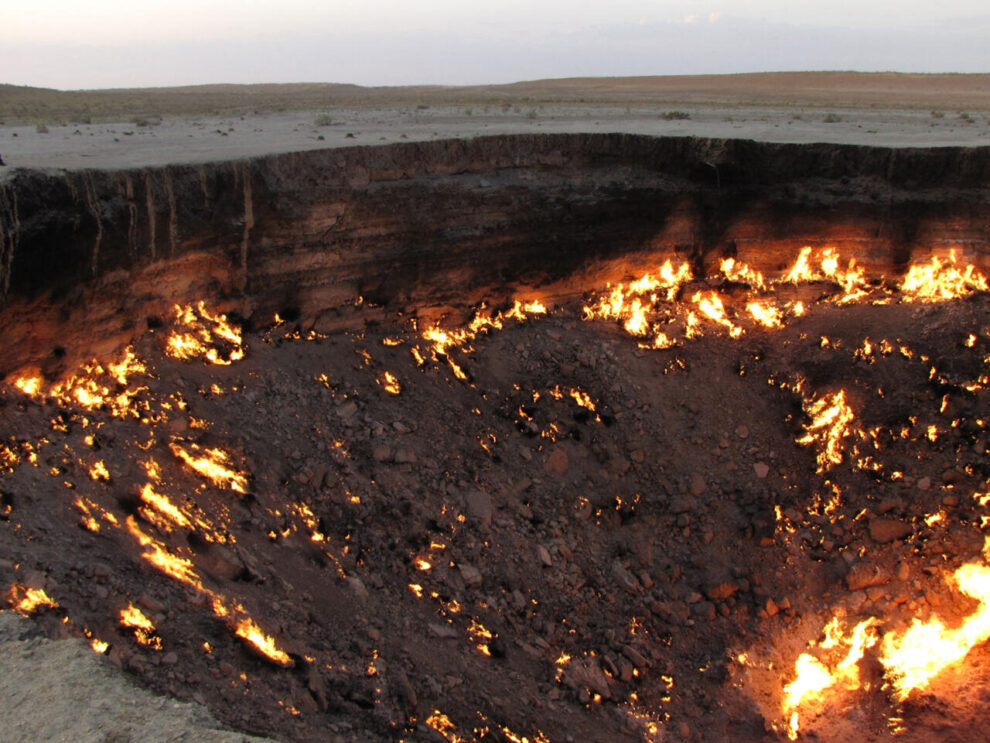Home to the Darvaza Crater, a massive molten pit that has spewed flames and noxious gases for decades, Turkmenistan has the world’s worst record when it comes to climate-heating methane leaks. As it pledges to plug the smouldering crater, the reclusive central Asian nation is under pressure to fix its leaking oil and gas industry, too.
Over the past half-century, the former Soviet republic has been grappling with a hellish leak it simply cannot plug.
Deep in the desert of Karakoum, in northern Turkmenistan, the Darvaza gas crater has been ablaze for the past 50 years, pumping fearsome quantities of methane gas into the atmosphere.
Dubbed the “Gateway to Hell”, the gaping crater has long been a rare tourist hot spot in a country where foreign visitors number about 6,000 a year.
With methane’s greenhouse effects increasingly in the spotlight, the gas-belching desert oddity has also attracted growing scrutiny from scientists and governments scrambling for ways to rein in catastrophic global warming.
A Soviet desert mystery
At 70 metres (229ft) wide and 20 metres deep, the smouldering Darvaza Crater is a surreal sight in an otherwise barren landscape. Its origin remains one of the former Soviet Union’s best-kept secrets.
The most widely accepted account points to a drilling operation gone awry back in 1971.
Soviet engineers, the story goes, were gauging the site’s oil reserves when they hit a gas cavern, causing the earth to collapse and releasing vast quantities of natural gas. With the site both hazardous and inoperable, the engineers decided to set it alight, planning to exhaust the cavern’s gas reserves in a matter of weeks – or so they thought.
But there are other theories, too.
In 2013, explorer George Kourounis became the first person to plumb the depths of the crater. In an interview with National Geographic, he said local geologists had offered different accounts regarding the crater’s formation.
“I’ve heard (…) that the collapse may have happened in the 1960s and that it went unlit until 1980s,” Kourounis said. “It’s hard for me to back that up, but this is basically straight from the horse’s mouth.”
Tip of the iceberg
Since Turkmenistan’s independence in 1991, the government has regularly floated plans to extinguish the “Gateway to Hell”.
“We are losing valuable natural resources for which we could get significant profits and use them for improving the well-being of our people,” the country’s former strongman leader Gurbanguly Berdymukhamedov said at the start of 2022, shortly before handing power to his son.
In reality, this titanic enterprise has never really been a priority for a country that sits on abundant oil and gas reserves – enough to provide free electricity, gas and water to its citizens over the three decades that followed independence.
This time, however, the reclusive central Asian country appears determined to snuff out the blaze, with help from the United States.
In late March, Bloomberg reported that the two countries were discussing a plan to extinguish the fire and capture the methane released by the crater. The plan would also see Washington provide much-needed investment in the country’s ageing oil and gas infrastructure.
While the spectacular “Gateway to Hell” has attracted most attention over the years, experts note that the Darvaza Crater is just the tip of the iceberg when it comes to gas leaks in Turkmenistan, one of the world’s top polluters despite a population of just six million.
Between 2019 and 2022, the country set an unflattering world record of 840 “super-emitter” events involving methane gas leaks from wells, storage sites and pipelines, according to satellite data supplied by the French start-up Karryos, whose efforts to monitor methane emissions around the world have exposed the staggering environmental cost of Turkmenistan’s oil and gas industry.
An environmental nightmare
Last year, methane leaks from Turkmenistan’s two main fossil fuel fields caused more global warming than the entire carbon emissions of the United Kingdom, Karryos data revealed.
“Until recently, we had little or no visibility on the subject,” said the start-up’s founder Antoine Rostand. “Now we know that Turkmenistan, but also Iraq, the United States and Russia, are among the countries whose oil and gas sector emit the largest quantities of methane.”
In Turkmenistan’s case, Rostand said the problem stemmed from a lack environmental standards and poor infrastructure maintenance. He noted that leaked natural gas is almost 100 times more polluting than flared – or burnt – methane.
Methane is the second most abundant gas in the atmosphere after CO2, and although it is less persistent in the air, its warming potential is around 80 times greater over a 20-year period. Leaks from fossil fuel installations sometimes stretch over several weeks, amounting to short-term climate bombs.
In an interview with FRANCE 24 last year, Euan Nisbet, a climate scientist at Royal Holloway University, pointed to an “extreme and unexpected increase in atmospheric methane” over the previous two years, describing the trend as “particularly worrying”.
“Compared with CO2, molecule by molecule, methane is much more harmful to our climate,” Nisbet added.
Cheap and effective
Earlier this week, Turkmenistan’s new President Serdar Berdimuhamedov unveiled a road map of measures aimed at tackling the country’s colossal gas leaks.
The initiative paves the way for the country to join 150 others that have already signed the Global Methane Pledge – negotiated at the COP26 climate summit in Glasgow – to cut global methane emissions by 30% by 2030.
The road map includes stepping up cooperation with foreign partners and the UN’s International Methane Emissions Observatory (Imeo), a move the agency’s head Manfredi Caltagirone described as “encouraging”.
“But after the announcements, the real work starts to actually cut emissions,” the Imeo chief cautioned in an interview with the UK’s Guardian newspaper.
Climate experts note that tackling methane gas leaks could deliver rapid and concrete results in the battle against global warming – without requiring major technological advances.
“According to our estimates, halving the number of methane ‘super-emitter’ events over the next two years would be just as effective as fitting every car in Europe with an electric engine,” said Rostand.
Despite the modest cost of plugging such leaks, the oil and gas industry, which accounts for 40% of all methane emissions, has been reluctant to take action, lamented the International Energy Agency (IEA) in its latest “Global Methane Tracker” report published in February. An investment of $100 billion – equivalent to “less than 3% of the net income received by the oil and gas industry in 2022” – would be sufficient to avoid three quarters of all methane leaks caused by the industry, the IEA wrote.
According to the Intergovernmental Panel on Climate Change (IPPC), a 45% reduction in methane emissions by 2030 would prevent a global temperature increase of 0.3°C over the next 20 years – placing the reduction of methane emissions among humanity’s best chances of limiting global warming.
Source: France24















